|
 |
| Adult, Contra Costa County |
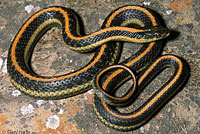 |
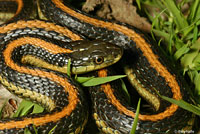 |
 |
 |
| |
Adult, Contra Costa County |
|
 |
 |
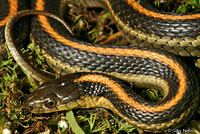 |
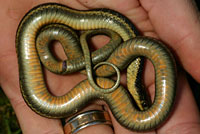 |
| Adult, Contra Costa County |
Adult, Contra Costa County |
 |
 |
 |
 |
| Adult, Contra Costa County |
Adult in shallow water,
Contra Costa County |
Adult, Contra Costa County |
Adult, Contra Costa County
|
 |
 |
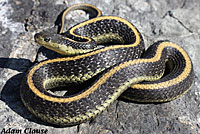 |
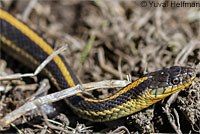 |
Adult, San Luis Obispo County © Ryan Sikola
This species is so rare at the edge of its range in San Luis Obispo and Santa Babara counties that it will breed with the more common Two-striped Gartersnake. See "Hybrids" below.
|
Adult, Alameda County
© Adam Clause
|
Adult, Alameda County
© Yuval Helfman |
 |
 |
 |
| Adult with bright yellow coloring, San Luis Obispo County © Joel Germond |
Adult, Monterey County
© Benjamin German |
 |
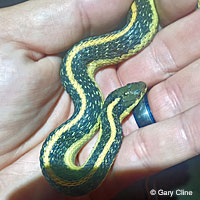 |
|
Juvenile and hatchling pond turtles basking next to a Diablo Range
Gartersnake in a Contra Costa County pond. © Mark Gary |
This snake was found at the supposed edge of the range of the subspecies, in Newman, Stanislaus County
© Gary Cline.
This made me wonder if that really is the edge of the range. If they are found in Newman, which is on the valley floor, I see no apparent reason why Diablo Range Gartersnakes cannot survive farther east into the valley anywhere along their range. If you have seen one outside the range shown on my map, please let me know. |
|
| |
|
|
|
| Juveniles |
 |
 |
 |
|
| Juvenile, Contra Costa County |
Neonate, late August,
Contra Costa County |
Juvenile, Contra Costa County |
|
| |
|
|
|
| Feeding |
 |
 |
 |
 |
Adult eating a Bullfrog tadpole in Santa Clara County. © Chad Lane
|
Janet heard squeaking then saw a gartersnake rolling and twisting down an incline. When they stopped, the snake was the victor in a struggle with a vole. Solano County. © Janet Ellis |
 |
 |
 |
 |
| Adult eating a frog (possibly a Foothill Yellow-legged Frog) at the edge of a creek in Santa Clara County © Douglas Brown |
An intergrade Aquatic Gartersnake in Napa County eats a frog (either a California Red-legged Frog or a Foothill Yellow-legged Frog.) © Pamela Delgado |
 |
 |
 |
|
 |
 |
 |
|
This series shows a Diablo Range Gartersnake eating a California Tiger Salamander larva in Contra Costa County.
The snake caught the larva in the water, then brought it to shore to swallow it. © Mark Gary |
|
 |
 |
 |
|
 |
 |
 |
|
This Diablo Range Gartersnake was observed in October eating a toxic California Newt in Alameda County at the edge of a newt breeding pond. You can see the snake biting the tail, then swallowing the newt tail first and then the head. You can read about gartersnakes eating toxic newts here. © Mark Gary
|
|
 |
 |
 |
|
| This tiny juvenile Diablo Range Gartersnake was observed in December eating a recently-transformed juvenile California Newt on the edge of the same newt breeding pond in Alameda County where the adult snake above was observed eating an adult newt. © Mark Gary |
|
| |
|
|
|
| Hybrids |
 |
 |
|
|
Adult, Santa Barbara County
© Ryan Sikola |
Adult, San Luis Obispo County
© Ryan Sikola |
|
|
These snake are unusual hybrids of the Diablo Range Gartersnake and the Two-striped Gartersnake, Thamnophis hammondii. Note the thin yellow vertebral stripe that is not present on T. hammondii and is much thinner than that found on T. atratus. T. atratus is so scarce at the edge of its range in San Luis Obispo and Santa Barbara counties that they breed with T. hammondii which is more abundant in the area.
|
|
|
| |
|
|
|
| Intergrades |
 |
 |
 |
 |
| Adult intergrade, Marin County |
Adult intergrade, Marin County |
Adult intergrade, Marin County |
Possible T. a. atratus x T. a. zaxanthus intergrade adult, Santa Clara County
© Jared Heald |
| North of the San Francisco Bay, there is a very large intergrade range mixing the subspecies T. a. hydrophilus, T. a. atratus, and T. a. zaxanthus. The snakes in this area were formerly classified as T. a. aquaticus (previously T. couchii aquaticus( but this subspecies is no longer recognized. More pictures and information about these intergrades can be seen here. |
|
| |
|
| Habitat |
 |
 |
 |
 |
Habitat, Contra Costa County
|
Habitat, spring, Contra Costa County
|
Habitat, spring, Contra Costa County |
Habitat, Alameda County |
 |
 |
 |
 |
Habitat, Contra Costa County
|
Habitat, small pond, Contra Costa County
|
Habitat, summer, Contra Costa County |
 |
 |
 |
|
Habitat, Alameda County
|
Habitat, Alameda County |
Habitat, 500 ft, western
Stanislaus County |
|
| |
|
|
|
| Short Videos
|
 |
 |
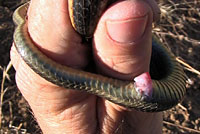 |
|
| Diablo Range Gartersnakes in and around a small cattle pond in Contra Costa County. |
Diablo Range Gartersnakes swimming in a cattle pond in Contra Costa County. |
When it is picked up, a big adult Diablo Range Gartersnake demonstrates how it smears foul-smelling fluids from its cloaca all over the hand of its tormentor. Too bad they haven't invented online video with smells yet.... |
|
|
|
|
|
|
Description |
Not Dangerous - This snake may produce a mild venom that does not typically cause death or serious illness or injury in most humans, but its bite should be avoided.
Commonly described as "harmless" or "not poisonous" to indicate that its bite is not dangerous, but "not venomous" is more accurate since the venom is not dangerous. (A poisonous snake can hurt you if you eat it. A venomous snake can hurt you if it bites you.)
Long-considered non-venomous, discoveries in the early 2000s revealed that gartersnakes produce a mild venom that can be harmfull to small prey but is not considered dangerous to most humans, although a bite may cause slight irritation and swelling around the puncture wound. Enlarged teeth at the rear of the mouth are thought to help spread the venom.
|
| Size |
Adults are 18 - 40 inches long (46 - 102 cm). Most snakes encountered are generally 18 - 28 inches long (46 - 71 cm).
Neonates are 7 - 10 inches ( 18 - 25 cm).
|
| Appearance |
A medium-sized slender snake with a head barely wider than the neck and keeled dorsal scales.
Some average scale counts: Average of 8 upper labial scales, 6 and 7 not enlarged. 11 lower labial scales. Rear pair of chin shields is longer than the front. The internasals are longer than they are wide and pointed in front. Average of 19 or 21 scales at mid-body.
The following description is from Boundy, Jeff. Systematics of the Garter Snake Thamnophis atratus at the Southern End of Its Range. Proceedings of the California Academy of Sciences Volume 51, No. 6, p. 328. 1999.
"...midbody scale rows 19 (85%) or 17 (15%)... vertebral stripe relatively broad, averaging 3.2 (range 1.5 - 5.0) scale rows on the nape... vertebral stripe yellow to orange-yellow; lateral stripe conspicuous, pale green; dorsum dark gray to black; iris gray or brown; top of head dark, olive black, with a prominent parietal spot; supralabial suture marks narrow when present; demarcation between dorsal head color and pale supralabials distinct; chin cream, becoming bright yellow on the throat, grading to pale green in the thoracic region; ventral color darkening slightly posteriorly; midventral suffusion yellow to orange; dark markings absent from transverse ventral sutures; eye moderate in size..."
|
| Color and Pattern |
Ground color is gray, brown or black.
There is distinct yellow or orange stripe on the back and a light stripe along the lower part of each side on the 2nd and 3rd scale rows.
There may be small alternating dark spots on the sides, most noticable on juveniles.
The throat is white or yellow, sometimes bright yellow.
The underside is bluish or greenish sometimes with pink or yellow marks. |
Key to Identifying California Gartersnake Species
|
| Life History and Behavior |
Activity |
A highly-aquatic snake, able to remain underwater, but also found away from water.
Active during the day, and after dark during very hot weather.
Can be active most of the year when conditions allow, but primarily found spring through fall. |
| Defense |
| When threatened, this snake will often escape into water, hiding on the bottom. If it is frightened when picked up, it will often strike repeatedly and release feces from the cloaca and expel musk from anal glands. |
| Diet and Feeding |
Probably eats mainly amphibians and their larvae, including frogs, tadpoles, and aquatic salamander larvae (newts) but small fish are also eaten, and possibly small rodents. Leeches are also consumed - I saw a recently-captured T. a. zaxanthus regurgitate two leeches.
Adults tend to forage actively. Neonates are sit-and-wait foragers. Juveniles practice both types of foraging.
Preston and Johnston, 2012, in their study of the diet of T. atratus in the Bay Area, found that native amphibians are a very important part of their diet, with Sierran Treefrogs being the most important amphibian prey, followed by California Toads, California Newts, and California Red-legged Frogs.
Toxic Newts
This species has been observed eating adult Pacific Newts (genus Taricha) which are deadly poisonous to most predators.
The Bay Area is the Center of an Evolutionary Race Between Hungry Snakes and Toxic Newts.
by Anton Sorokin. Bay Nature, April 6, 2022
Gartersnakes Can Become Poisonous
There is evidence that when Common Gartersnakes (Thamnophis sirtalis) eat Rough-skinned Newts (Taricha granulosa) they retain the deadly neurotoxin found in the skin of the newts called tetrodotoxin for several weeks, making the snakes poisonous (not venomous) to predators (such as birds or mammals) that eat the snakes. Since California Newts (Taricha torosa) also contain tetrodotoxin in their skin, and since gartersnake species other than T. sirtalis also eat newts, it is not unreasonable to conclude that any gartersnake that eats either species of newt is poisonous to predators.
Williams, Becky L.; Brodie, Edmund D. Jr.; Brodie, Edmund D. III (2004). "A Resistant Predator and Its Toxic Prey: Persistence of Newt Toxin Leads to Poisonous (Not Venomous) Snakes." Journal of Chemical Ecology. 30 (10): 1901–1919.) https://doi.org/10.1023/B:JOEC.0000045585.77875.09
|
| Reproduction |
Courtship has been observed during March and April.
Females are ovoviviparous - they carry the eggs internally until the young are born live from late summer to early fall.
|
| Habitat |
Creeks, streams, small lakes and ponds, in woodland, brush and forest and grassy ecotones. Seems to prefer shallow rocky creeks and streams.
When found in muddy ponds there are usually rocky outcrops nearby.
|
| Geographical Range |
This subspecies, Thamnophis atratus zaxanthus - Diablo Range Gartersnake, is endemic to California. According to Boundy, 1999 in his original description of this snake, Thamnophis atratus zaxanthus occurs in the "inner Coast Range from Napa and Solano to Santa Barbara counties and the Santa Lucia Range." This includes the East Bay south along the southern edge of the Santa Cruz Mountains where this subspecies interegrages with T. a. atratus.
The species Thamnophis atratus - Aquatic Gartersnake, ranges from Santa Barbara County north through the coast ranges into southwest Oregon.
|
 |
| Notes on Taxonomy |
For a long time T. atratus was considered a subspecies of T. couchii. In 1987 it was classified as a distinct species. In 1999 Boundy revised the species to include T. a. zaxanthus.
North of the San Francisco Bay, there is a very large intergrade range between T. a. hydrophilus, T. a. atratus, and T. a. zaxanthus. The snakes in this area were formerly classified as T. a. aquaticus (previously T. couchii aquaticus.)
T. a. zaxanthus is still classified as T. a. atratus by some researchers.
Alternate and Previous Names (Synonyms)
Thamnophis atratus zaxanthus - Diablo Range Garter Snake (Stebbins & McGinnis 2012)
Thamnophis atratus zaxanthus - Diablo Range Garter Snake Boundy, 1999
Thamnophis couchi atratus - Santa Cruz Garter Snake (Stebbins 1966, 1985, 2003)
Thamnophis couchi aquaticus - Aquatic Garter Snake (Stebbins 1966, 1985)
Thamnophis elegans aquaticus (Stebbins 1954)
Thamnophis elegans atratus (Stebbins 1954)
Thamnophis elegans aquaticus (Fox 1951)
Thamnophis elegans atratus (Kennicott 1860)
Black garter snake (Yarrow 1882)
Northern California coast garter
Middle California garter snake
Pacific coast garter snake
Single-striped garter snake
Western garter snake
|
| Conservation Issues (Conservation Status) |
| Not known to be threatened, but gartersnakes have been negatively impacted by competition with introduced bullfrogs in some areas. |
|
| Taxonomy |
| Family |
Colubridae |
Colubrids |
Oppel, 1811 |
| Genus |
Thamnophis |
North American Gartersnakes |
Fitzinger, 1843 |
| Species |
atratus |
Aquatic Gartersnake |
(Kennicott, 1860) |
Subspecies
|
zaxanthus |
Diablo Range Gartersnake |
Boundy, 1999 |
|
Original Description |
Thamnophis atratus - (Kennicott, 1860) - in Cooper, Expl. Surv. R.R. Miss. Pacific, Vol. 12, Book 2, Pt. 3, No. 4, p. 296
Thamnophis atratus zaxanthus - Boundy, 1999. Proc. California Acad. Sci. 51:328
from Original Description Citations for the Reptiles and Amphibians of North America © Ellin Beltz
|
|
Meaning of the Scientific Name |
Thamnophis - Greek - thamnos - shrub or bush, and ophis - snake, serpent
atratus - Latin - clothed in black, mourning - refers to the dark dorsal color
zaxanathus - Greek - za - good or intensive, and xanthus - yellow - refers to an "abundance of yellow on the dorsal pattern in contrast to other populations of T. atratus." Boundy, 2002 pers. comm.
from Scientific and Common Names of the Reptiles and Amphibians of North America - Explained © Ellin Beltz
|
| Other California Gartersnakes |
T. a. atratus - Santa Cruz Gartersnake
T. a. hydrophilus - Oregon Gartersnake
T. couchii - Sierra Gartersnake
T. gigas - Giant Gartersnake
T. e. elegans - Mountain Gartersnake
T. e. terrestris - Coast Gartersnake
T. e. vagrans - Wandering Gartersnake
T. hammondii - Two-striped Gartersnake
T. m. marcianus - Marcy's Checkered Gartersnake
T. ordinoides - Northwestern Gartersnake
T. s. fitchi - Valley Gartersnake
T. s. infernalis - California Red-sided Gartersnake
T. s. tetrataenia - San Francisco Gartersnake
|
|
More Information and References |
California Department of Fish and Wildlife
Boundy, Jeff. Systematics of the Garter Snake Thamnophis atratus at the Southern End of Its Range. Proceedings of the California Academy of Sciences Volume 51, No. 6, pp. 311-336. 1999.
Rossman, Douglas A., Neil B, Ford, & Richard A. Siegel. The Garter Snakes - Evolution and Ecology. University of Oklahoma press, 1996
Stebbins, Robert C., and McGinnis, Samuel M. Field Guide to Amphibians and Reptiles of California: Revised Edition (California Natural History Guides) University of California Press, 2012.
Stebbins, Robert C. California Amphibians and Reptiles. The University of California Press, 1972.
Flaxington, William C. Amphibians and Reptiles of California: Field Observations, Distribution, and Natural History. Fieldnotes Press, Anaheim, California, 2021.
Samuel M. McGinnis and Robert C. Stebbins. Peterson Field Guide to Western Reptiles & Amphibians. 4th Edition. Houghton Mifflin Harcourt Publishing Company, 2018.
Stebbins, Robert C. A Field Guide to Western Reptiles and Amphibians. 3rd Edition. Houghton Mifflin Company, 2003.
Behler, John L., and F. Wayne King. The Audubon Society Field Guide to North American Reptiles and Amphibians. Alfred A. Knopf, 1992.
Powell, Robert., Joseph T. Collins, and Errol D. Hooper Jr. A Key to Amphibians and Reptiles of the Continental United States and Canada. The University Press of Kansas, 1998.
Bartlett, R. D. & Patricia P. Bartlett. Guide and Reference to the Snakes of Western North America (North of Mexico) and Hawaii. University Press of Florida, 2009.
Bartlett, R. D. & Alan Tennant. Snakes of North America - Western Region. Gulf Publishing Co., 2000.
Brown, Philip R. A Field Guide to Snakes of California. Gulf Publishing Co., 1997.
Ernst, Carl H., Evelyn M. Ernst, & Robert M. Corker. Snakes of the United States and Canada. Smithsonian Institution Press, 2003.
Wright, Albert Hazen & Anna Allen Wright. Handbook of Snakes of the United States and Canada. Cornell University Press, 1957.
Daniel L. Preston and Pieter T. J. Johnson. Importance of Native Amphibians in the Diet and Distribution of the Aquatic Gartersnake (Thamnophis atratus) in the San Francisco Bay Area of California. Journal of Herpetology 46(2):221-227. 2012
|
|
|
The following conservation status listings for this animal are taken from the January 2024 State of California Special Animals List and the January 2024 Federally Listed Endangered and Threatened Animals of California list (unless indicated otherwise below.) Both lists are produced by multiple agencies every year, and sometimes more than once per year, so the conservation status listing information found below might not be from the most recent lists. To make sure you are seeing the most recent listings, go to this California Department of Fish and Wildlife web page where you can search for and download both lists:
https://www.wildlife.ca.gov/Data/CNDDB/Plants-and-Animals.
A detailed explanation of the meaning of the status listing symbols can be found at the beginning of the two lists. For quick reference, I have included them on my Special Status Information page.
If no status is listed here, the animal is not included on either list. This most likely indicates that there are no serious conservation concerns for the animal. To find out more about an animal's status you can also go to the NatureServe and IUCN websites to check their rankings.
This snake is not included on the Special Animals List, which indicates that there are no significant conservation concerns for it in California.
|
| Organization |
Status Listing |
Notes |
| NatureServe Global Ranking |
|
|
| NatureServe State Ranking |
|
|
| U.S. Endangered Species Act (ESA) |
None |
|
| California Endangered Species Act (CESA) |
None |
|
| California Department of Fish and Wildlife |
None |
|
| Bureau of Land Management |
None |
|
| USDA Forest Service |
None |
|
| IUCN |
|
|
|
|
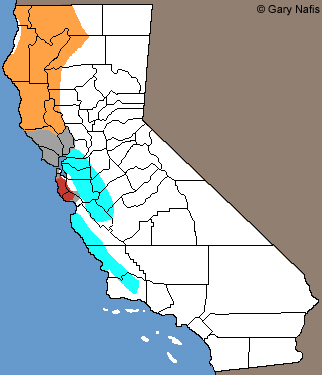 Light Blue: Range of this subspecies in California
Light Blue: Range of this subspecies in California





































































